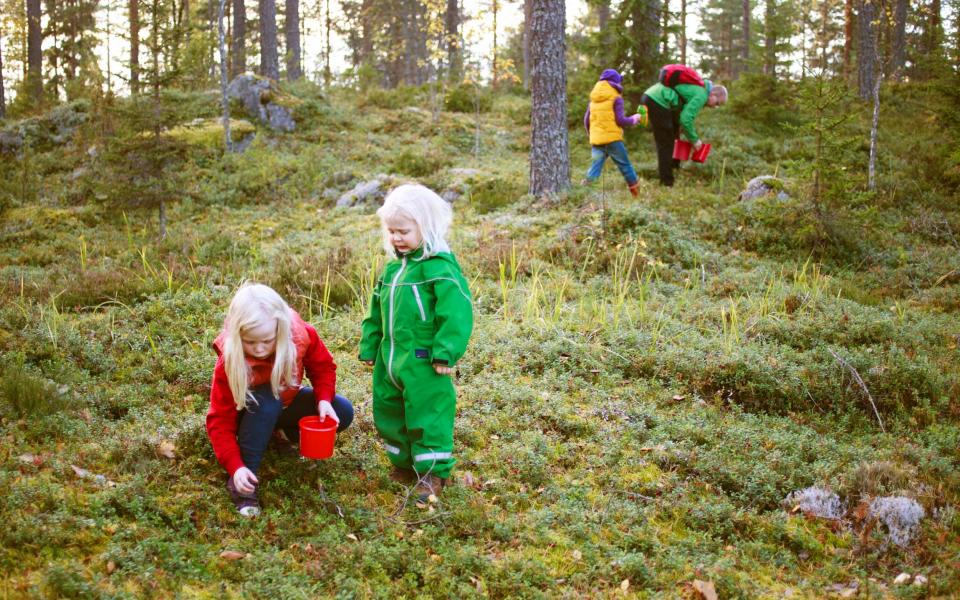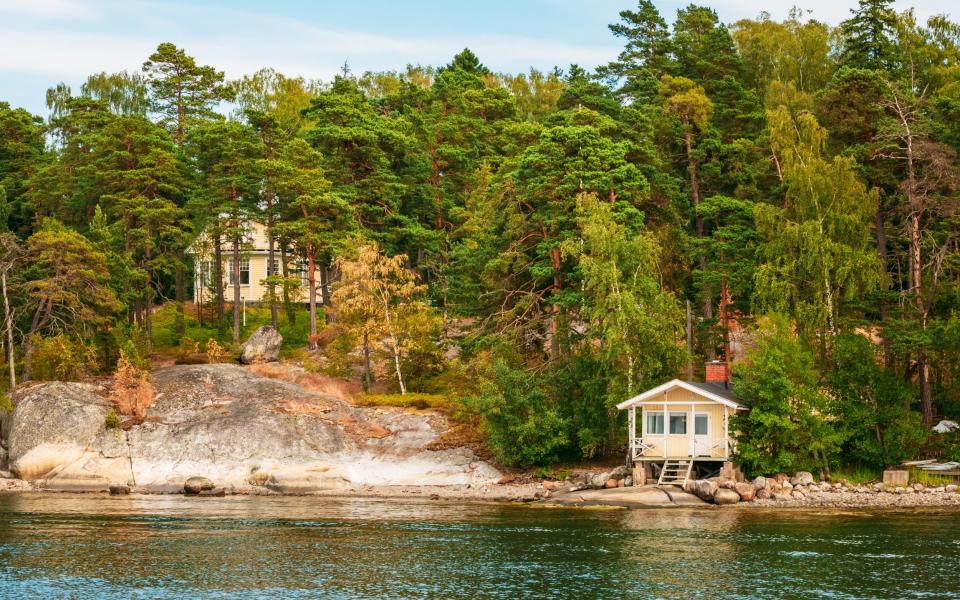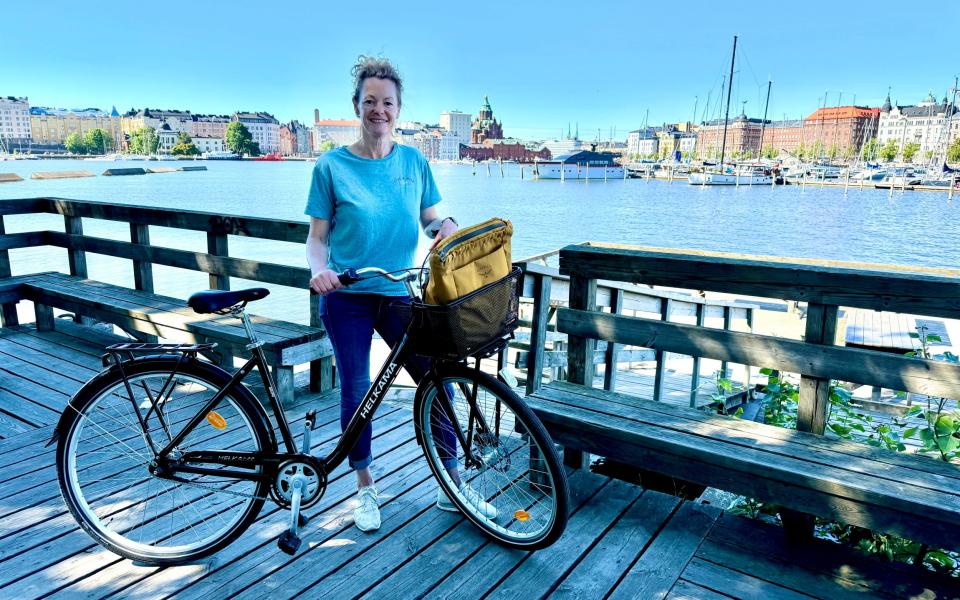A woman in a felt pixie hat is scooping water onto stones heated by the wood stove. Hot steam is billowing in a great hissing cloud around us, and she is swinging bundles of birch logs into it before handing one to us.
“It’s good for the circulation!” she beams, throwing the leaves over her shoulders and back.
I cast aside my typically British scepticism and join in. I beat my sweaty limbs with the fragrant bouquets until the heat and sweat become too much and I walk out the door and sink into the deliciously cool waters of the Kymi River.
Saunas, I discovered, are as fundamental to Finnish life as eating and sleeping. In a country with a population of about 5.5 million, there are apparently 3.5 million saunas – equal to the number of cars.

In the old days, a family would build a sauna before they built a house. Women would have children in it. The dead would be prepared for burial in it. According to Jaana, with whom I shared another sauna in Helsinki, the houses scattered across the islands and lakes where Finnish families spend their summers are often very basic. “They may not have running water or electricity, but they all have a sauna,” she says.
“It’s the place where you can completely relax, where you don’t have to think about anything. When I stay in our family cottage, I love preparing the sauna; chopping wood and lighting the fire. I read a book while I wait for it to warm up. It’s very relaxing and therapeutic.”
Maybe the Finns are on the right track. The World Happiness Report thinks so. Earlier this year, Finland was named the happiest country in the world for the seventh year in a row.


According to Carlos, the Portuguese-born co-owner of Helsinki’s bustling Restaurant Elm, there are several factors that contribute to the country’s general sense of contentment: “Finnish society is very egalitarian. There are no private schools, but the education system here is considered one of the best in the world. Taxes are high, but people pay them willingly and see the benefit.”
In 2017, the city gifted its citizens with a new library – an architecturally stunning building with rooms and resources like 3D printers available to visitors. There are even music studios, fully equipped and free for anyone to use.
Entrepreneurs are encouraged and financially supported. Furthermore, most of the shops I see when cycling through the streets of Helsinki are not large international chains, but independent shops that proudly sell products that are designed and made locally.


Food also plays an important role. In a country where the growing season is short, home chefs and restaurants like Helsinki’s Natura cook according to what is local and seasonal.
My visit coincided with the first new potatoes of the season, wild strawberries and herbs. In a month or so the cloudberries and lingonberries would be ripe, followed by mushrooms and cranberries. And Niina, the tireless owner of the island’s restaurant Vaaku, told me that “everyone has the right to forage anywhere. You can’t cut down trees or dig up plants, but you can pick whatever you want.”
Government policy aside, Finland’s green and blue spaces provide a general sense of cheerfulness. My first few days were spent an hour’s drive east of Helsinki, staying at a river camp between the towns of Kotka and Hamina.


I slept in a small A-frame hut, the walls of which faced the river and were made entirely of glass, so that it seemed as if the bed were actually floating on the flowing water. I ate salmon cooked on a fire, with salad and the first new potatoes of the year. I ran along forest paths, canoed on the backwaters and walked among the birch, spruce and pine trees, all the while being sung to by cuckoos.
I also took a boat to Ulko-Tammio, one of the hundreds of islands that make up the archipelago off Finland’s southern coast. Some smart aleck at the local tourist office thought that designating the island “phone-free” might generate some interest. It worked, and the pleasure visitors got from heeding the polite notice on the jetty’s shore suggesting they turn off their phones and just enjoy the island’s natural beauty has meant that what started as a PR stunt has become an intrinsic part of the island’s identity.
In northern Finland, the forests are home to animals that have disappeared from much of the rest of Europe. For anyone who wants to experience the unforgettable joy of seeing a wolf or a bear (or the almost mythical wolverine) in the wild, Lassi’s Camp among the trees, right on the Russian border, is a good place to start.
Lassi Rautiainen was an early pioneer of wildlife photo tourism and his hides are positioned to give photographers the best chance of capturing the perfect shot of these iconic species. He leaves out food, something I wasn’t entirely happy with. “But it’s no different than putting out food for the birds in your garden,” he points out. “The animals only come if they want to. The food is an encouragement, not a guarantee.”
On long summer days, the animals are more active at night. I settled into the hide at 5pm with water, a sleeping bag and snacks in preparation for a 15-hour shift. The sky through the slit windows was a shifting watercolour of grey and blue.
I looked out over a tree-lined meadow, cotton grass dancing in the wind. Then, magically, a wolf arrived. Slinky and leggy, with intense amber eyes, he stalked, cautious and alert, then gradually relaxed, allowing me to watch him closely.
Then a bear walked along the edge of the forest. Two more wolves appeared. After an exchange of words, the bear was chased away and the wolves took over. I sat there, spellbound. How often do you get the chance to just sit and watch the night pass and the morning unfold, undisturbed and undisturbed?
Elys and her Scottish husband Rob had just moved into Lentiira, a hamlet of red wooden holiday cottages set between the shores of a lake and a wildflower meadow, full of flowers and buzzing with bees. On Midsummer’s Eve I gathered with other guests and locals of all ages to sing as the Finnish flag was raised and a festive bonfire was lit.
Rob, an astronomer who takes his guests on a star tour of our solar system during the darkest times of the year, fired up a special sauna to mark the occasion. He lit the fire in a room with no chimney, which quickly filled it with smoke.
Then the smoke was allowed to escape and the room was hosed down, leaving a steaming blanket of heat. We sat, feeling slightly like herrings, in the sooty interior, letting the smoky warmth envelop us until the cool, dark waters of the lake beckoned. Then we floated under the midnight sun, watching the swallows still tending their nests under the eaves of our cottages.
Finnish writer Tove Jansson claimed in her acclaimed novel The summer book that “only swallows houses where people are happy”. How right she was.
Essential
Kate was a guest of Visit Finland, Visit Kotka Hamina (visitkotkahamina.fi) and Helsinki Partners (helsinkipartners.com).
Get there
Finnair (0330 8081188; finnair.com) flies to Helsinki from Heathrow, Manchester and Edinburgh from £166 return, including all taxes and charges.
Stay there
In Helsinki she stayed at Hotel St. George (stgeorgehelsinki.com/), where prices start at €350 per night. For a full review and to book, visit telegraph.co.uk/travel/destinations/europe/finland/helsinki/hotels/hotel-st-george/
In Kotka Hamina she stayed at Erämys Keisarinkosket Laawu (eramys.fi/en/laawu-kultaa), which offers double rooms from €195 including sauna and breakfast. She also stayed at Laawu Wellsters (wellsters.fi/majoitus/laawu/), which offers double rooms from €290.
In the Arctic Lake District she was a guest of Wild Taiga (wildtaiga.fi/en/), which organises wildlife tours and photo safaris from €100 per person.
More information
See visitfinland.com